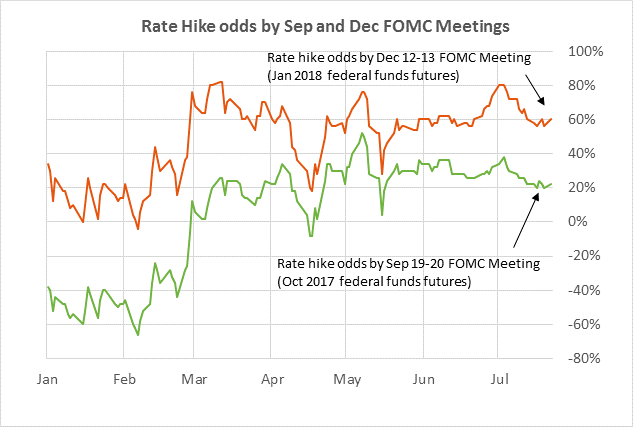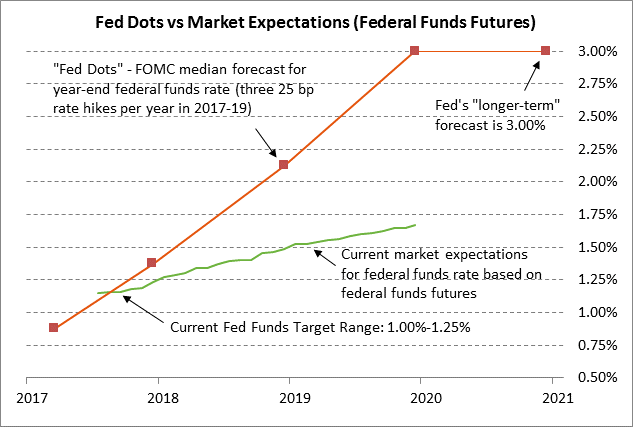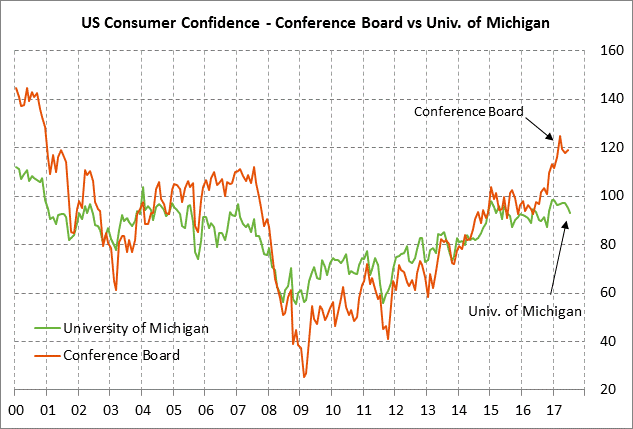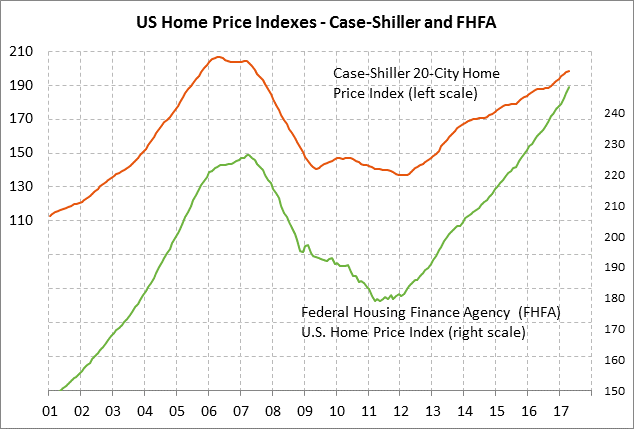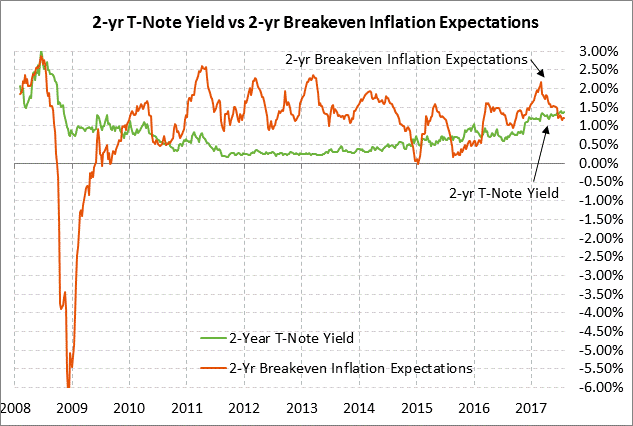- FOMC begins 2-day policy meeting with a chance for a balance sheet announcement
- Today’s Senate vote on health care has implications for tax reform
- U.S. consumer confidence expected to give back a bit more of the post-election surge but remain strong
- U.S. home prices expected to remain strong
- 2-year T-note auction to yield near 1.37%
FOMC begins 2-day policy meeting with a chance for a balance sheet announcement — The FOMC today begins its 2-day policy meeting. There will be a post-meeting statement as usual but no post-meeting press conference by Fed Chair Yellen. The odds for a Fed rate hike this week are very low at 12%, according to the federal funds futures market. However, there is perhaps a 40%-50% chance in our view that the FOMC at this week’s meeting will announce the start date for its balance sheet reduction program.
The market consensus is that the FOMC will wait until its next meeting on Sep 19-20 to announce the start date. However, if the FOMC plans to start its balance sheet reduction program on Oct 1 so that it coincides with calendar quarters, then a Sep 19-20 announcement would give the markets only a 10-day heads-up before the program starts. For that reason, the FOMC may decide to announce the start date this week to give the markets more time to prepare for the program.
One caveat to an Oct 1 start for the balance sheet is that the Fed cannot begin its balance sheet reduction program until Congress raises the debt ceiling, which must be done by early to mid-October, according to the CBO. The Fed could still announce an Oct 1 start date for the balance sheet program, but might make that start date conditional on a debt ceiling hike. The Fed might avoid the whole debt ceiling problem by waiting until September to announce the program and then start the program on Nov 1 or Dec 1.
The odds for the Fed’s next rate hike have fallen in recent weeks mainly because of soft inflation data. The markets are discounting the odds of the Fed’s next rate hike at only 22% by the Sep 19-20 FOMC meeting, 26% by the Oct 31/Nov 1 meeting, and 60% by the Dec 12-13 meeting.
Today’s Senate vote on health care has implications for tax reform — Senate Majority leader McConnell plans to hold a procedural vote on Tuesday on a motion to proceed with bringing the health care bill to the Senate floor for consideration and amendments. Mr. McConnell at this point is simply trying to get a health care bill on the floor with at least 51 Republican votes and he has not yet decided which health care versions will get an actual vote. It remains to be seen whether Mr. Connell has enough votes to get a health care bill on the floor, let alone get a final bill passed.
The markets are carefully watching the health care legislation, mainly because of its implications for an eventual tax reform bill. If Congress repeals Obamacare and its taxes, then Republicans will be able to devise a much larger tax reform bill.
U.S. consumer confidence expected to give back a bit more of the post-election surge but remain strong — The market consensus is for today’s July Conference Board U.S. consumer confidence index to show a -2.9 point decline to 116.0, more than reversing June’s +1.3 point increase to 118.9. The consumer confidence index soared after the Nov 2016 election and posted a 16-1/2 year high of 124.9 in March. The index has since fall by a net -6.0 points from the 16-1/2 year high but remains historically very strong.
Despite the recent decline, U.S. consumer sentiment is still in generally strong shape at +7.9 points above the pre-election level. Supportive factors for consumer sentiment include the strong labor market, near-record highs in the stock market, rising home prices, rising household wealth, hopes for a tax cut, and low gasoline prices.
U.S. home prices expected to remain strong — U.S. home prices in May are expected to continue to rise. The consensus is for the May FHFA house price index to show another strong increase of +0.5% m/m, adding to April’s +0.7% m/m increase. Meanwhile, the consensus is for today’s May S&P CoreLogic Composite-20 home price index to show a +0.3% m/m increase, matching April’s +0.3% increase. U.S home prices this year have shown strong increases. On a year-on-year basis, the FHFA index in May was up +6.8% y/y and the Composite-20 index was up +5.6% y/y.
U.S. home prices have been very strong in recent months due to strong demand and tight supply. U.S. existing home sales in June were strong at 5.52 million units, which was only -3.2% below the 10-year high of 5.70 million units posted in March. Meanwhile, the supply of homes on the market was mildly tight at 4.3 months in June, which is below the 2000-05 average of 4.5 months and well below the long-term average of 7.0 months.
2-year T-note auction to yield near 1.37% — The Treasury today will auction $26 billion of 2-year T-notes. The Treasury will then continue this week’s $103 billion T-note package by selling $15 billion of 2-year floating rate notes and $34 billion of 5-year T-notes on Wednesday, and then $28 billion of 7-year T-notes on Thursday. Today’s 2-year T-note issue was trading at 1.37% in when-issued trading late Monday afternoon. That translates to an inflation-adjusted yield of 0.15% against the current breakeven 2-year inflation expectations rate of 1.22%.
The 12-auction averages for the 2-year are as follows: 2.73 bid cover ratio, $166 million in non-competitive bids to mostly retail investors, 4.4 bp tail to the median yield, 21.8 bp tail to the low yield, and 53% taken at the high yield. The 2-year is the least popular coupon security among foreign investors and central bank. Indirect bidders, a proxy for foreign buyers, have taken an average of only 45.0% of the last twelve 2-year T-note auctions, which is well below the average of 60.2% for all recent Treasury coupon auctions.

